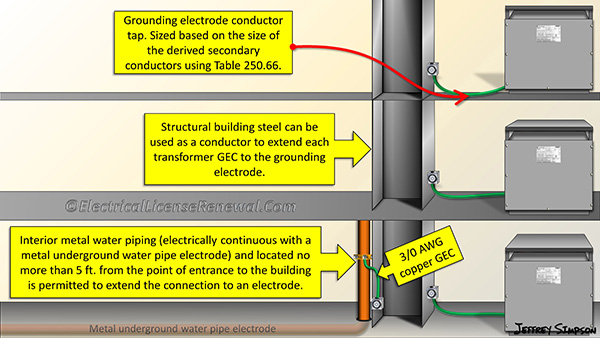250.30(A)(6)(a) Grounding Electrode Conductor, Multiple Separately Derived Systems.

Code Change Summary: Proper methods for grounding multiple separately derived systems have been revised and expanded.
Section 250.30(A)(6) provides details on using a common grounding electrode conductor (GEC) and individual grounding electrode conductor taps in order to properly bond multiple separately derived systems. The NEC® does not specifically require a common GEC but using this method results in the least amount of wire and labor. If a common GEC is used, the rules in 250.30(A)(6) will apply.
In the 2014 NEC®, this section required the common GEC to be one of the following:
(1) A conductor of the wire type not smaller than 3/0 AWG copper or 250 kcmil aluminum.
(2) The metal frame of the building or structure that complies with 250.52(A)(2) or is connected to the grounding electrode system by a conductor that shall not be smaller than 3/0 AWG copper or 250 kcmil aluminum.
- If using item 2 above, basically the metal building frame either needed to qualify as a grounding electrode or be connected to a qualifying grounding electrode by not smaller than a 3/0 AWG copper or 250 kcmil aluminum conductor.
In the 2017 NEC®, this section was revised to allow the common GEC to be one of the following:
(1) A conductor of the wire type not smaller than 3/0 AWG copper or 250 kcmil aluminum.
(2) A metal water pipe that complies with 250.68(C)(1).
(3) The metal structural frame of the building or structure that complies with 250.68(C)(2) or is connected to the grounding electrode system by a conductor not smaller than 3/0 AWG copper or 250 kcmil aluminum.
- In order to use new item 2 above, the water pipe must comply with 250.68(C)(1) which means it must qualify as a grounding electrode and be connected to within the first 5 feet from the point of entrance to the building.
- In order to use new item 3 above, the revised wording makes it clear that the metal frame of the building must be “structural”. As well, the structural metal must now comply with 250.68(C)(2) which pertains to using the steel as conductor to interconnect electrodes instead of 250.52(A)(2) which has been revised and now applies to “metal in-ground support structures” being used as an actual grounding electrode.
Below is a preview of Article 250. See the actual NEC® text at NFPA.ORG for the complete code section. Once there, click on their link to free access to the 2017 NEC® edition of NFPA 70.
2014 Code Language:
250.30(A)(6)
(a) Common Grounding Electrode Conductor. The common grounding electrode conductor shall be permitted to be one of the following:
(1) A conductor of the wire type not smaller than 3/0 AWG copper or 250 kcmil aluminum
(2) The metal frame of the building or structure that complies with 250.52(A)(2) or is connected to the grounding electrode system by a conductor that shall not be smaller than 3/0 AWG copper or 250 kcmil aluminum
2017 Code Language:
250.30(A)(6)
(a) Common Grounding Electrode Conductor. The common grounding electrode conductor shall be permitted to be one of the following:
(1) A conductor of the wire type not smaller than 3/0 AWG copper or 250 kcmil aluminum
(2) A metal water pipe that complies with 250.68(C)(1)
(3) The metal structural frame of the building or structure that complies with 250.68(C)(2) or is connected to the grounding electrode system by a conductor not smaller than 3/0 AWG copper or 250 kcmil aluminum